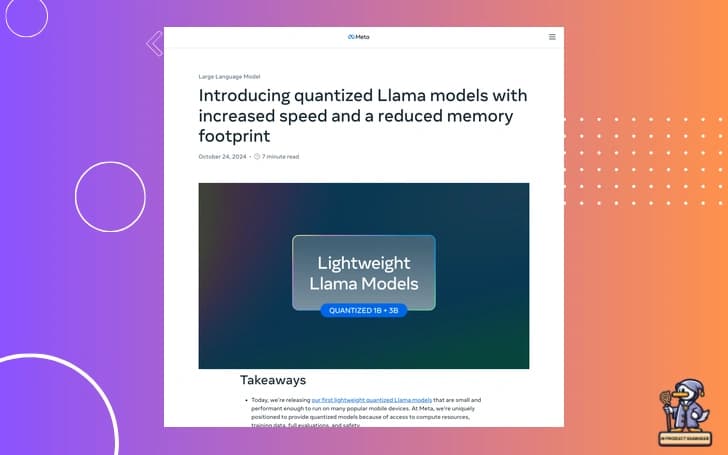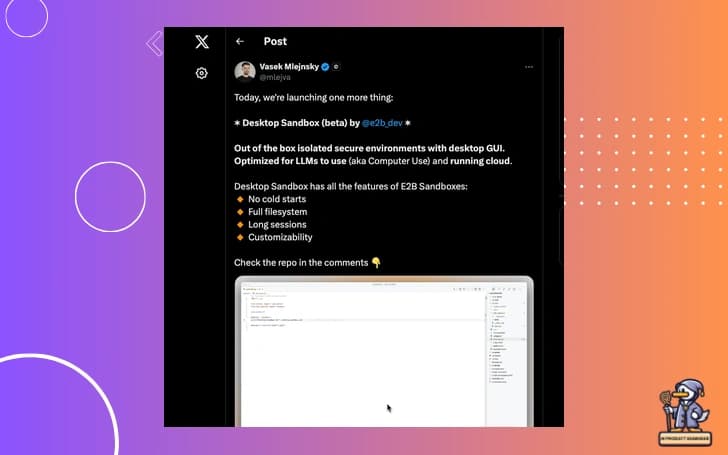🚀 Welcome to QuackChat: The DuckTypers' Daily AI Update
Hello fellow DuckTypers, Jens here from Munich. Today we're diving into some significant developments in AI optimization and deployment. As an engineer who's spent decades architecting software systems, I find these developments particularly interesting from a practical implementation perspective.
🔧 Meta's Quantization Breakthrough

Meta has made a significant engineering advancement with their quantized versions of Llama models. Let me break this down from a technical perspective:
Quantization Architecture
# Meta's quantization scheme
class QuantizationConfig:
def __init__(self):
self.transformer_config = {
"linear_layers": {
"weights": "4-bit groupwise", # group_size=32
"activations": "8-bit per-token dynamic"
},
"classification_layer": {
"weights": "8-bit per-channel",
"activations": "8-bit per-token dynamic"
},
"embedding": "8-bit per-channel"
}Performance Improvements
-
Speed:
- Decode latency: 2.5x improvement
- Prefill latency: 4.2x improvement
- Time-to-first-token (TTFT) optimized for 64-token prompts
-
Resource Efficiency:
- 56% reduction in model size
- 41% reduction in memory usage
- Optimized for 8K context window
Implementation Approaches
- Quantization-Aware Training (QAT) with LoRA
# Example QAT + LoRA setup
def setup_qat_lora():
model = AutoModelForCausalLM.from_pretrained("meta-llama/Llama-2-3B")
# Initialize QAT
qat_config = QuantizationConfig(
bits=4,
group_size=32,
scheme="dynamic"
)
# Apply LoRA adapters
lora_config = LoRAConfig(
r=16, # LoRA rank
target_modules=["q_proj", "v_proj"],
trainable=True
)
return prepare_model_for_qat(model, qat_config, lora_config)- SpinQuant for Post-Training
# SpinQuant implementation example
class SpinQuantizer:
def quantize_model(self, model, calibration_data):
# Use WikiText for calibration
rotation_matrices = self.learn_rotations(
model,
calibration_data
)
# Apply quantization with learned rotations
quantized_model = self.apply_quantization(
model,
rotation_matrices,
bits=4
)
return quantized_modelHardware Support
- Verified on multiple devices:
- OnePlus 12
- Samsung S24+ (1B and 3B models)
- Samsung S22 (1B model)
- iOS devices (accuracy verified, performance pending)
Loading and Usage
# Modern loading approach with quantization
from transformers import AutoModelForCausalLM, AutoTokenizer
def load_quantized_model(model_id: str, quantization_config: dict):
model = AutoModelForCausalLM.from_pretrained(
model_id,
device_map="auto",
quantization_config=quantization_config,
torch_dtype="auto"
)
tokenizer = AutoTokenizer.from_pretrained(model_id)
return model, tokenizer
# Usage example
config = {
"bits": 4,
"group_size": 32,
"scheme": "dynamic"
}
model, tokenizer = load_quantized_model(
"meta-llama/Llama-2-3B-quantized",
config
)Mobile Optimization Focus
# Example mobile-optimized inference setup
class MobileOptimizedInference:
def __init__(self, model, max_context=8192):
self.model = model
self.max_context = max_context
def optimize_for_device(self, device_type):
if device_type == "android":
return self.setup_android_optimizations()
elif device_type == "ios":
return self.setup_ios_optimizations()
def setup_android_optimizations(self):
# Kleidi AI kernels optimization
return {
"threads": 4,
"batch_size": 1,
"use_kleidi": True
}Engineering Considerations:
- Short-context optimization (up to 8K tokens)
- Mobile CPU-specific optimizations via Kleidi AI kernels
- Future NPU support in development
- ExecuTorch framework integration
Question for Fellow Engineers: How are you handling the trade-off between model size and inference speed in your mobile deployments? Have you found specific quantization configurations that work particularly well for your use case?
Note: All performance metrics were measured on actual devices using an adb binary-based approach. Your results may vary based on specific hardware and implementation details.
🔐 Claude 3.5: Power vs Privacy
An interesting development that warrants careful consideration is Claude 3.5's new computer control capabilities. From an engineering perspective, this raises several architectural concerns:
- System boundary definition
- Permission management
- Data access controls
Here's a simple pseudocode example of how we might want to implement safety checks:
def validate_system_access(request):
if not is_authorized_scope(request.scope):
raise SecurityException("Operation not permitted")
if exceeds_rate_limit(request):
raise ThrottlingException("Rate limit exceeded")
log_access_attempt(request)⚡ Cerebras Sets New Speed Records

Cerebras has achieved remarkable inference speeds with their new chip:
- Over 2,100 tokens/s with Llama3.1-70B
- 16x faster than current GPU solutions
- 8x faster than GPUs running Llama3.1-3B
As an engineer, I find their architecture particularly interesting. Let's look at a theoretical comparison:
# Traditional GPU Pipeline
def gpu_inference(input_text):
# Multiple memory transfers required
gpu_memory = transfer_to_gpu(input_text)
output = model.generate(gpu_memory)
return transfer_to_cpu(output)
# Cerebras Pipeline
def cerebras_inference(input_text):
# Single memory space, no transfers
return model.generate(input_text)🛠️ Development Tools Update

The E2B Desktop Sandbox beta represents an interesting approach to local LLM development. Let me break this down from an engineering perspective:
Architecture Overview
# Example E2B configuration
config = {
"environment": {
"runtime": "python3.9",
"gpu_support": True,
"filesystem_access": {
"read_paths": ["/app", "/data"],
"write_paths": ["/output"]
},
"network": {
"isolated": True,
"allowed_hosts": ["api.openai.com"]
}
}
}Key Features in Detail
-
Filesystem Support
- Isolated file system with controlled access patterns
- Separate read/write permissions for different paths
- Persistent storage for model weights and datasets
# Example of secure file access def safe_file_access(path: str, mode: str): if not is_allowed_path(path, mode): raise SecurityException("Access denied") return open(path, mode) -
Environment Customization
- Python version selection
- Dependency management
- GPU passthrough configuration
# Example environment.yaml name: llm-dev dependencies: - python=3.9 - torch>=2.0 - transformers - custom-packages: - path: ./local/deps -
Security Features
- Process isolation
- Network traffic control
- Resource usage limits
# Resource limitation example resource_limits = { "memory": "16G", "cpu_count": 4, "gpu_memory": "8G", "network_bandwidth": "1Gbps" }
Practical Implementation
Here's how you might set up a development workflow:
from e2b import Sandbox
async def dev_workflow():
# Initialize isolated environment
sandbox = Sandbox(
template="python3.9-gpu",
env_vars={"OPENAI_API_KEY": "sk-..."}
)
# Mount local project
await sandbox.mount("./project", "/app")
# Run development server
process = await sandbox.process.start({
"cmd": "python serve.py",
"cwd": "/app"
})
# Monitor resources
stats = await sandbox.process.stats()
print(f"Memory usage: {stats.memory_usage}MB")Best Practices
-
Environment Management
- Keep environments minimal and specific
- Document dependencies explicitly
- Use version pinning for reproducibility
-
Security Considerations
- Implement least-privilege access
- Regular security audits
- Monitor resource usage
-
Development Workflow
- Use CI/CD compatible configurations
- Implement automated testing
- Maintain parity with production
Comparison with Traditional Methods
| Feature | E2B Sandbox | Docker | Virtual Env |
|---|---|---|---|
| Isolation | Complete | Complete | Partial |
| GPU Support | Native | Required Setup | Limited |
| Setup Time | Minutes | Hours | Minutes |
| Resource Control | Fine-grained | Container-level | Basic |
Engineering Considerations
-
Performance Impact
- Minimal overhead compared to bare metal
- Efficient resource sharing
- GPU passthrough optimization
-
Integration Points
# Example integration with existing tools class SandboxedModel: def __init__(self, model_path: str): self.sandbox = Sandbox() self.model = self.sandbox.load_model(model_path) async def predict(self, input_data): return await self.sandbox.run_inference( self.model, input_data )
Question for the Community: How do you balance the trade-off between isolation security and development speed in your AI projects? Have you found certain tools or patterns particularly effective?
This kind of structured environment becomes increasingly important as we work with larger models and more complex deployments. I'd love to hear about your experiences with similar tools.
📊 Engineering Corner: Performance Metrics
Let's break down the current inference speeds we're seeing across different platforms:
| Platform | Tokens/Second | Context |
|---|---|---|
| Cerebras | 2,100 | Current benchmark leader using their new chip architecture |
| Quantized Llama | 393 | Using Meta's new quantization techniques, achieving 3x standard GPU speed |
| Standard GPU | 131 | Baseline performance on typical GPU setups |
Let's break down what we're seeing:
-
Cerebras Performance (2,100 t/s)
- Almost 5x faster than the quantized model
- Achieves this through specialized hardware
- Represents the current speed ceiling
-
Quantized Llama (393 t/s)
- 3x improvement over standard GPU
- Software-only optimization
- Good balance of speed vs. implementation cost
-
Standard GPU (131 t/s)
- Baseline performance
- Traditional floating-point operations
- Common in most deployments
The table shows a clear exponential pattern in performance gains, where:
- Hardware optimization (Cerebras) provides the biggest jump
- Software optimization (quantization) offers meaningful but smaller improvements
- Each tier approximately triples the performance of the previous one
Engineering Insight: The exponential performance increase suggests that combining these approaches (hardware + quantization) might yield even better results. However, the cost-benefit ratio becomes increasingly important as we move up the performance ladder.
Note: Performance may vary based on specific workloads and configurations.
🤝 Community Insights from Discord
From analyzing several Discord discussions, I've noticed several emerging patterns in how teams are approaching AI deployment. Let me break these down from an engineering perspective:
1. Edge Deployment Optimization
# Example of quantization-aware training setup
class EdgeOptimizedModel:
def __init__(self, base_model, quantization_config):
self.model = optimize_for_edge(
base_model,
bits=quantization_config.bits,
scheme="dynamic"
)
def prepare_for_device(self, target_device):
# Adapt model for specific edge hardware
return self.model.optimize_for_target(
device=target_device,
memory_limit="4GB"
)Teams are focusing on:
-
Model Compression Techniques
- Knowledge distillation for smaller models
- Dynamic quantization based on hardware
- Pruning unnecessary weights
-
Hardware-Specific Optimization
- Custom kernels for mobile processors
- Battery-aware inference scheduling
- Memory footprint reduction
2. Privacy-Preserving Methods
# Example of private inference setup
class PrivateInference:
def __init__(self):
self.encryption = self.setup_homomorphic_encryption()
def process_sensitive_data(self, input_data):
encrypted_data = self.encryption.encrypt(input_data)
result = self.model.infer(encrypted_data)
return self.encryption.decrypt(result)
def audit_trail(self):
return self.get_anonymized_logs()Key approaches include:
-
Local Processing
- On-device inference
- Federated learning implementations
- Encrypted computation pipelines
-
Data Protection Measures
- Input anonymization
- Differential privacy techniques
- Secure enclaves usage
3. Resource Utilization
Teams are implementing:
-
Dynamic Scaling
class ResourceManager: def __init__(self, resource_pool): self.resources = resource_pool self.usage_metrics = {} def allocate_resources(self, request): # Dynamic allocation based on load if self.is_high_priority(request): return self.get_dedicated_resources() return self.get_shared_resources() -
Batch Processing Optimization
class BatchProcessor: def __init__(self, model, batch_size=32): self.model = model self.batch_size = batch_size self.queue = [] async def process_batch(self): if len(self.queue) >= self.batch_size: batch = self.queue[:self.batch_size] results = await self.model.batch_inference(batch) self.queue = self.queue[self.batch_size:] return results
4. Deployment Patterns
Popular approaches seen in Discord:
| Pattern | Use Case | Trade-offs |
|---|---|---|
| Blue-Green | Zero-downtime updates | Higher resource usage |
| Canary | Gradual rollouts | Complex monitoring needed |
| Shadow | Production testing | Additional infrastructure |
5. Monitoring and Debugging
Teams are implementing comprehensive observability:
class ModelMonitor:
def __init__(self):
self.metrics = {
'latency': [],
'throughput': [],
'error_rate': [],
'resource_usage': []
}
def log_inference(self, start_time, end_time, success):
latency = end_time - start_time
self.metrics['latency'].append(latency)
self.metrics['error_rate'].append(0 if success else 1)6. Emerging Best Practices
From the community discussions:
-
Model Versioning
model_registry = { 'v1.0': {'path': '/models/v1', 'sha': 'abc123'}, 'v1.1': {'path': '/models/v1.1', 'sha': 'def456'}, 'latest': {'path': '/models/v1.1', 'sha': 'def456'} } -
Error Handling
class RobustInference: def handle_error(self, error_type): if error_type == "OOM": return self.fallback_to_cpu() elif error_type == "TIMEOUT": return self.retry_with_smaller_batch() -
Cost Management
- Token usage tracking
- Batch size optimization
- Caching strategies
Question for the Community: What deployment patterns have you found most effective for maintaining high availability while managing costs? Have you developed any unique solutions for resource optimization?
🎯 Looking Ahead
As we continue to see these developments, I encourage you to think about:
- How can we implement these optimizations in our own projects?
- What security measures should we consider?
- How do we balance performance with resource constraints?
Remember to share your thoughts and experiences in the comments below. Your practical insights help our community grow stronger.
Happy coding, DuckTypers! 🦆


